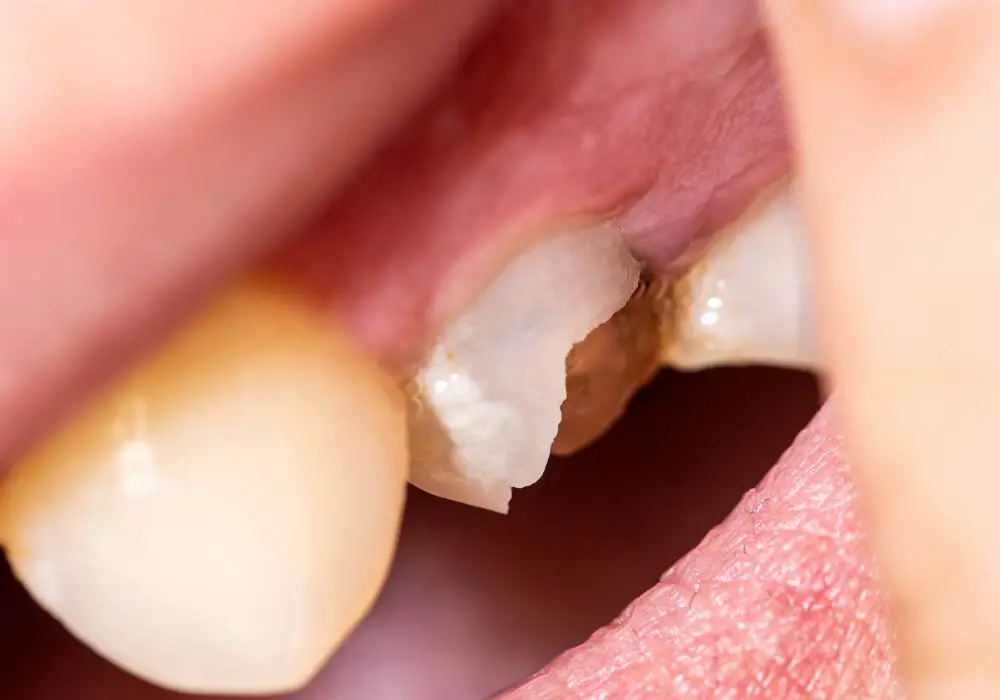Many people notice that the edges of their teeth feel rough or uneven. This is actually completely normal and there are a few key reasons why the ends of teeth often lack a smooth finish. Understanding the causes in more depth can help you determine if your tooth edges are within the range of normal or if you need to address an underlying issue.
Enamel Erosion

Enamel is the hard, outer layer that covers the crown of teeth. It helps protect the sensitive dentin underneath. Enamel is the hardest substance in the human body and it normally provides teeth with a smooth, glossy surface.
Over time, enamel can erode due to:
Acidic Foods and Drinks
Frequent consumption of acidic foods and beverages can erode enamel. Things like citrus fruits, vinegars, carbonated drinks, wine, and fruit juices contain acids that can dissolve enamel over time, leaving teeth prone to damage. The ends of teeth are often the most affected since they take the brunt of chewing forces and direct exposure to the acids. Acids essentially dissolve or “eat away” at the enamel surface, creating tiny pits and eventually porous, rough areas.
Fruit juice and wine are especially problematic because people tend to sip them slowly, bathing teeth in acid for an extended duration. Carbonated soda combines acidity with sugars that can further demineralize enamel.
Tooth Grinding/Clenching
Grinding or clenching your teeth, particularly at night, can wear down enamel over time. This abrasion usually affects the biting surfaces and edges of teeth the most. The excessive forces placed on teeth during these habits literally rub away enamel, almost like sanding it down. This leaves pitted areas and a rough texture.
Nighttime grinding is particularly problematic because saliva flow decreases during sleep. Saliva helps neutralize and rinse acids from the mouth. With less flow at night, any acids or abrasive forces just sit and work on enamel for hours at a time.
Gastroesophageal Reflux Disease
With GERD, stomach acid flows back into the mouth which bathes teeth in acid. Like acidic foods and drinks, this erodes enamel and leaves tooth edges feeling rough. The lower back molars are typically most affected since they receive the brunt of the acid exposure.
When stomach acid flows into the esophagus and mouth it drastically lowers the pH balance of oral fluids. Extended duration of low pH acidic conditions softens and dissolves enamel. The back molars near the throat are most prone to this because of gravity and their positioning.
Gum Recession
Gum recession occurs when gums pull away from teeth, exposing more of the tooth surface. This is usually a result of periodontal disease or aggressive brushing habits over time. As more enamel becomes exposed and unprotected by the gums, the area may feel rough or uneven.
Gums provide a cushioning barrier that shields enamel from temperature changes and abrasive forces during chewing. Once they recede, enamel is more vulnerable to wearing down or chipping, especially near the new gum line.
The gum line is also more prone to sensitivity due to the exposed dentin. Dentin contains hollow tubes that transmit sensations and pain signals when unprotected. Advanced gum recession can even lead to tooth loosening if too much root structure becomes exposed.
Normal Wear and Variations in Enamel
Even with good oral care, enamel can slowly wear down over decades of use, leaving edges a bit rough feeling. This is because enamel contains an intricate internal micro-structure that becomes less organized with age. Enamel rods and hydroxyapatite crystals run in an aligned pattern that gives tooth surfaces their smooth, glassy appearance. As this arrangement deteriorates over time, microscopic holes develop, reducing enamel integrity and creating a rougher texture.
Enamel thickness and smoothness also varies naturally from tooth to tooth based on position in the mouth and genetics. So some teeth may always feel slightly more textured, even in childhood. Mild variations are normal as long as no cracking or chipping occurs. But substantial roughness requires an evaluation to rule out unhealthy causes.
Cracks or Chips

Cracks or chips in enamel leave indentations that make tooth edges feel uneven. Causes include:
- Trauma/injury – a fall or blow to the mouth can generate powerful blunt forces that crack teeth
- Biting hard objects – things like ice, hard candy, nuts or seeds can crack enamel under pressure
- Teeth grinding – forces exerted during grinding/clenching can micro-fracture enamel over time
- Previous dental work – the edges of old dental fillings or crowns may not blend smoothly with natural enamel
In some cases, cracks are so small they are barely visible to the eye. But over time, they propagate and expand, eventually becoming noticeable as a sharp, jagged edge. Cracks also allow bacteria and acids inside the tooth, increasing decay risk.
Cavities
Tooth decay from cavities damages enamel, leaving stained, pitted areas that make the edge feel rough. Cavities most often occur in the grooves of molars and between teeth where plaque bacteria can accumulate. As acid byproducts of the bacteria demineralize enamel, tiny holes form, eventually growing into a larger cavity.
Untreated decay worsens over years, spreading destruction deeper into dentin and tooth structure. The rough, cavity rim of the remaining enamel becomes more pronounced and may show brownish discoloration. Advanced decay undermines the integrity of enamel until islands shell off entirely, leaving an uneven, sharp edge.
Diagnosing the Cause
If you notice rough tooth edges, see your dentist to determine the exact cause. They will thoroughly examine your teeth under bright lighting and magnification. X-rays or even 3D CT scans may be ordered to check for issues like cracks, cavities forming between teeth, gum recession, or other problems.
Based on all findings from the clinical and radiographic examination, your dentist will determine the reasons for enamel roughness and explain your treatment options. It is important to get an accurate diagnosis so the underlying condition can be properly treated.
Treatment Options
1. Dental Fillings or Inlays/Onlays
Dental fillings come in tooth-colored composite resin materials or silver amalgam. They repair cracks or cavities that are leaving edges feeling rough. The material is molded and sculpted to precisely fit the defect and surround enamel walls. When polished smooth, fillings restore a uniform, even finish to the edge.
In some cases, inlays or onlays may be used instead. These are indirect fillings fabricated from porcelain or composite resin in a dental laboratory. They provide excellent durability and margins for more extensive decay or cracks.
2. Dental Bonding
Bonding applies a putty-like composite resin material that is molded and sculpted over chips or uneven areas. It is carefully shaped and then hardened using a special curing light. When finished properly, bonding blends almost seamlessly with natural enamel for a smooth, restored edge.
3. Dental Crowns
Crowns completely cover and cap damaged teeth to rebuild the original shape, function, and aesthetics. The crown restoration fits over the remaining tooth structure and smooths out any uneven or rough edges. Crowns are made of strong materials like porcelain fused to metal, zirconia, or lithium disilicate to provide lasting durability.
4. Gum Grafts
For areas of recession that are exposing rough enamel edges near the gum line, a gum graft can help cover exposed sections. This protects regions of roughness that are prone to sensitivity while smoothing sharp edges. A periodontist takes tissue from the roof of the mouth or another donor site to cover receded gums.
5. Night Guards
Custom night guards worn while sleeping cushion teeth from grinding forces. This prevents further enamel abrasion so teeth feel smoother. Night guards are also used to protect any dental restorations like crowns or veneers from damage during clenching and grinding while sleeping.
6. Addressing Dietary Acids
Reducing acidic food/drink consumption can help prevent future enamel erosion. Avoid overindulging in things like citrus fruits and juices, vinegars, wine, carbonated soda, etc. Drink water to help rinse acids from the mouth after consumption. Wait at least 30 minutes before brushing after acids since teeth are in a softened state.
7. Medications or Surgery for GERD
Medications like antacids, H2 blockers, and proton pump inhibitors can reduce reflux and acid exposure for GERD. In severe cases, a surgeon can tighten the esophageal sphincter to prevent backflow. This protects teeth from bathing in corrosive stomach acid.
Maintaining Tooth Enamel

Good daily and professional dental care helps maintain enamel integrity and tooth edge smoothness. Try to:
- Brush twice daily with a soft brush and fluoride toothpaste
- Floss at least once per day and avoid aggressive flossing motions
- Use products like prescription strength fluoride gels or toothpastes made for enamel strengthening
- Have regular dental cleanings every 6 months and exams to detect problems early
- Wear a custom mouthguard during sports to prevent fractures and trauma
- Avoid chewing on hard items like ice, pens, nuts or hard candy
- Monitor and moderate acid intake from foods and drinks
- Wear a night guard if you grind or clench your teeth
With proper prevention and treatment, you can keep your tooth enamel strong and edges feeling smooth. Be sure to see your dentist regularly for an evaluation if you notice increasing roughness or sensitivity. Catching issues early allows for more conservative, cost-effective solutions before extensive, irreversible damage occurs.
Frequently Asked Questions
What causes rough feeling edges on teeth?
The main causes are enamel erosion, gum recession, cracks/chips, cavities, and normal variations in enamel thickness. Acidic foods, grinding, trauma, decay, and aging can leave enamel feeling textured or uneven along tooth edges.
Are rough tooth edges normal?
Mild enamel variations that leave edges slightly rough are common and normal. But increasing roughness, sensitivity, or jagged areas indicate a problem needing treatment. Severe roughness is not simply part of aging.
How can you fix rough feeling teeth?
Treatment depends on the cause but may include fillings, inlays, bonding, crowns, gum grafts, night guards, addressing dietary acids, GERD management, and practicing good daily/professional dental care.
Can rough edges be prevented?
You can help prevent roughness by protecting teeth from trauma and acids, wearing mouthguards during sports, avoiding hard foods/items, using strengthening fluoride products, and seeing your dentist regularly for care.
When should you see a dentist for rough tooth edges?
See your dentist if roughness is increasing, your teeth are becoming sensitive, or you notice cracked enamel or receding gums. This allows early diagnosis and more conservative treatment before major enamel loss occurs. Don’t delay treatment.







